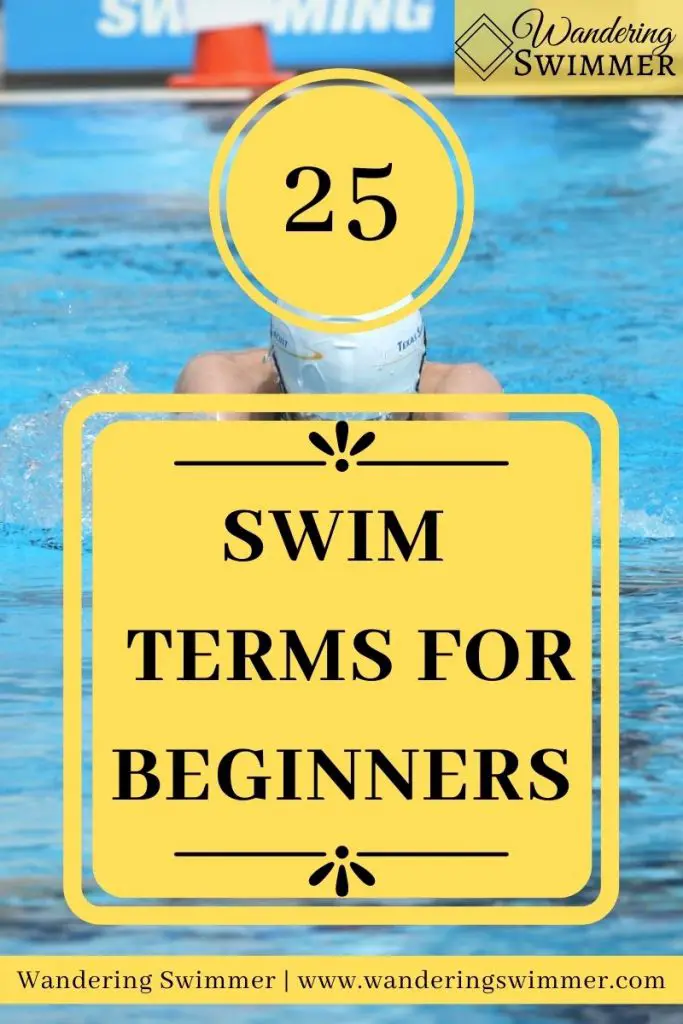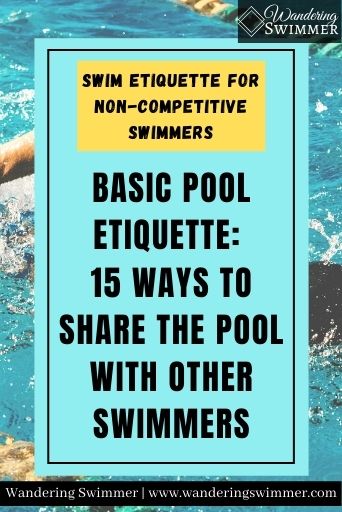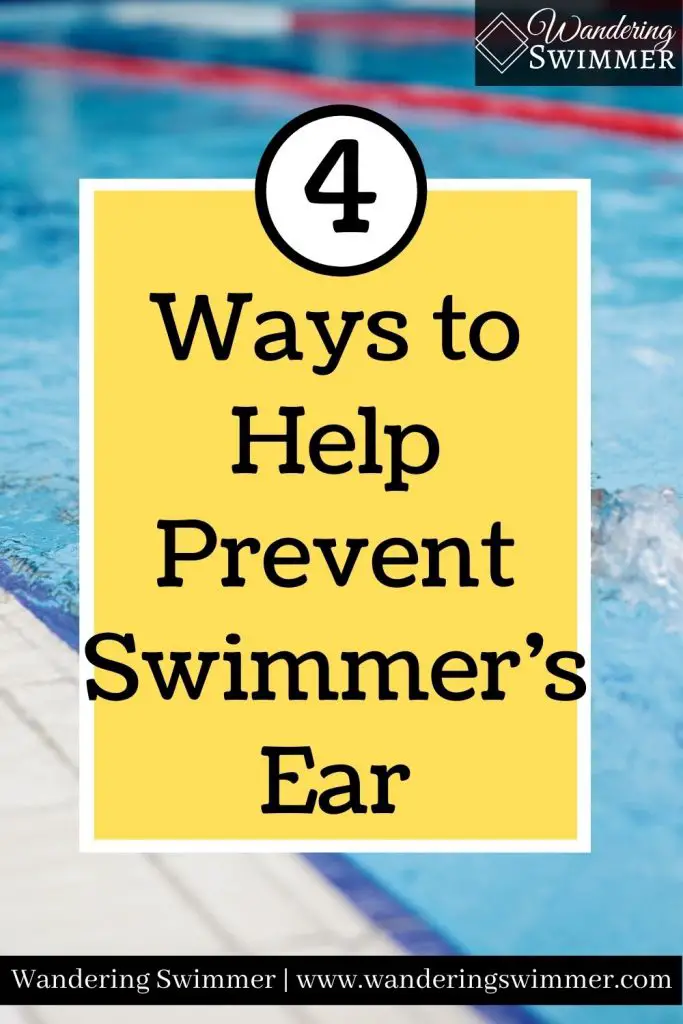If you just started to swim, you might find that the basics of swimming can be overwhelming. From the variety of different swim etiquette that you need to navigate a crowded pool to the needed equipment.
It’s enough to make your head swim! Pardon the pun 😉
Let us help you wrap your arms around some swimming basics to help you feel comfortable at the pool.
Below is a brief overview of some basic swimming topics to help you get started. All the information you’ll need on swimming basics in one quick glance. And hopefully, they’ll help you answer the questions that you might have.
If you’re wanting to learn how to swim, we recommend that you start with our Quick Guide to Swim Lessons article first.
Disclosure: This post may contain affiliate links, meaning I earn a small commission at no cost to you if you purchase something through one of my links. As an Amazon Associate, I earn from qualifying purchases. Please check out my disclosure page for more information.

- Basic Swimming Terminology
- What is Swim Etiquette?
- Hydration During Swimming
- Swimming and Eating
- What is Swimmer’s Ear?
- What Type of Swimsuit Should I Wear?
- Do I Need any Gear or Equipment to Start Swimming?
- Why Should I Wear a Swim Cap?
- Can I Swim on My Period?
- How Can You Eliminate the Smell of Chlorine?
- Bonus Content
Basic Swimming Terminology
The basics of swimming begins with swimming terminology.
Swimming has a plethora of swim jargon that sounds almost like another language. Knowing some swimming terminology, or swim terms will help you navigate the pool just a bit easier.
Certain words are specific to the pool itself and how to swim in it. While others focus more on gear, equipment, and strokes.
Two important words to familiarize yourself with are:
- Circle swimming: This occurs when swimmers move down the right-hand side of the lane and return by coming down the right-hand side of the lane. One easy way to remember this is that you always keep the lane line to your right side (left when on your back).
- Feet first entry: A safe means to enter the pool if you don’t plan to use a ladder. Most pools will request that you enter with your feet first instead of diving in.

What is Swim Etiquette?
Swim etiquette, in short, is the rules and unspoken agreements to swim with others in a generous manner. This ensures the safety of everyone in the pool.
Some basic swim etiquette consists of:
- Swimming in the correct direction of the lane. This can be either circle swimming or reverse circle swimming
- Respecting other swimmers in the lane by waiting at least five seconds before leaving behind them
- Not taking other equipment that belongs to other swimmers. To include water bottles
- Picking up after yourself when you finish your swim
Related article: Do’s and Don’ts of Swim Etiquette
While most of these rules are universal, we will put a standard disclaimer that some rules vary by location.

Hydration During Swimming
One misconception when swimming is that you don’t have to stay hydrated while you’re in the water because you don’t sweat.
And while it might seem hard to believe, you actually do sweat when you’re swimming! Especially if you’re swimming outdoors or in hot water.
Keep a bottle of water or some sort of sports drink at the end of your lane. And don’t just keep it there to look pretty. Make sure you actually drink it!
Related article: Reusable Water Bottles and COVID
Staying hydrated during practice helps prevent cramps, headaches, and sore muscles. Plus, it keeps your body fueled so it can continue to work out.
Swimming and Eating
Disclaimer: I’m not a doctor or health care provider. Check with your health care provider to determine a nutrition or workout plan that best suits you.
Should you eat before swimming?
Truthfully, it depends on the person and what you’re eating. Eating a large meal, especially if it’s greasy, just before getting into the water can make you sick. Or it could make you cramp up.
However, a small snack or meal about an hour or so before getting in the pool probably will not hurt.
That said, always consult your doctor if you have questions about eating before you swim. If you opt not to speak with your health care provider, start small and see how you feel.
While you should eat something small before you plan to work out – either at the gym or in the pool – you have to approach it in a smart manner. Too little can cause you to feel lightheaded. Too much though can make you sick.

What is Swimmer’s Ear?
Disclaimer: I’m not a doctor or health care provider. Check with your health care provider to see if ear drops are the best option for you. They shouldn’t be used if you have ear tubes, ruptured eardrums, or other ear issues.
Swimmer’s ear (otitis externa) is caused by water that stays in the outer ear canal and allows bacteria to grow.
While younger swimmers tend to get swimmer’s ear, adults can also suffer from it, too. If not treated, you can suffer from pain in your ear and muffled hearing. When left untreated for too long, swimmer’s ear can turn into something worse.
Related article: What is Swimmer’s Ear?

To help prevent swimmer’s ear, use ear drops whenever you submerge your head in the water. Whether that’s the pool, a shower or bath, or just playing in the rain. 🙂
After you get out of the pool, put a few drops in each ear. Rub behind the ear (near the base) to help disperse the drops better.
You can buy drops that are specifically for drying out ears after swimming. Or, you can make your own mixture.
If ear drops aren’t for you, consider using earplugs designed for swimming and wear a cap to help keep them secure.
More Content for You: 6 Best Earplugs for Swimmers
What Type of Swimsuit Should I Wear?
This is truly a personal choice based on your preference. However, we will note that some swimsuits are better for lap and leisure swimming than sitting poolside.
When looking at swimsuits, you’ll want to ensure that you have a good fit. One that’s not too tight that it digs into your shoulders or hips. But not too loose that it will slide right off.
- Women can wear a one-piece, a tankini, or a two-piece swimsuit. We would recommend something with a more closed back and front, if only so you can move around easier.
- Men can wear swim trunks, jammers, or even swim briefs if they like. Try not to let the swim trunks run too long so that it interferes with your kick. Your trunks should stop just above your knees.
Make sure you try on your swimsuit before heading to the pool to ensure the fit.
Not comfortable with wearing just a swimsuit? Consider the option of a swim shirt or rash guard!
Related articles:
- Answering Your Questions About Rash Guards
- What to Look for in a Women’s One Piece Swimsuit
- How to Pick a Two-Piece Swimsuit
- What is a Tankini? (And Why You Should Have One)
- 6 Swimsuit Back Styles Explained
- Ultimate Guide for Women’s Swimwear
- Best Women’s Swimsuits for Lap Swimming and Training
Do I Need any Gear or Equipment to Start Swimming?
While you don’t need any gear or equipment to start swimming, it’s a good idea to have at least some gear. At a minimum, we recommend that you consider getting a cap and goggles. And a swimsuit, for obvious reasons 🙂
Related articles:
- How to Pick the Right Swim Goggle
- How to Fix Common Swim Goggle Problems
- 7 Ways to Make Your Swimsuit Last Longer
Swimming for long periods of time without goggles can make your eyes burn. Wearing goggles will help prevent this and help you see better when you’re swimming. Whereas a swim cap will keep your hair out of your face when swimming and protect it from the chlorine.
Aside from a cap and goggles, you don’t need much else to get started swimming!
Why Should I Wear a Swim Cap?
If you have long hair or if you want to protect your hair from chlorine damage, you should wear a cap.
Related articles:
Swim caps serve additional benefits aside from protecting your hair. They also help keep your hair out of your face. This helps to ensure that you can breathe and see easier when swimming.
Additionally, they keep hair out of the pool. This protects other swimmers from getting a strand or two on their face or wrapped around their fingers when they swim. Which, is about as gross as it sounds.
If you don’t like wearing a cap because it’s uncomfortable or if your swim cap slides off, consider looking at different types of caps. Between a latex, lycra, and a silicon cap, you might find one that you like!
Can I Swim on My Period?
Disclaimer: These are only my opinions, thoughts, and observations contained in this post. They are provided only for informational purposes and shouldn’t be used or considered as medical advice. I’m not a doctor or medical practitioner. I encourage you to speak with your doctor or health care provider if you have questions regarding swimming during your period.
Yes. 100% you can absolutely swim while you’re on your period.
The chemicals in the pool will handle any leaks that might occur. And let’s be honest. More people pee in the pool than menstruate in the pool.
Just be sure to wear a product. A menstrual cup or tampons are the best products to use while swimming on your period. Remember to change out your tampon frequently to avoid TSS.
Related article: Swimming on Your Period FAQ
Not only can you swim while on your period, but you should swim while on your period. Any form of exercise really is great for you during that time of the month.
The only thing we will note is that if you’ve recently had any type of vaginal or uterus type surgery recently, you should definitely consult with your doctor first.
Best Menstrual Cup for Swimming on your Period
The DivaCup comes in three different sizes to accommodate for various flows. It’s soft but still firm enough that there’s no worry about leaks.
Menstrual cups are safe to use in and out of the water, and are a safer alternative to tampons.
How Can You Eliminate the Smell of Chlorine?
Based on how much you’re in the pool, good luck!
For those individuals who swim constantly, the smell tends to linger even after you shower. Certain products such as TRISWIM Body Wash or TRIHARD Body Wash are specific for chlorine removal can help to remove the smell though.
If you aren’t in the water frequently, a shower alone will help. However, it can take a day or two for the smell to disappear completely.
Be sure to launder your swim towels at the end of the week. This helps prevent the smell from building up. It also helps keep it from smelling like mold.
Lastly, don’t forget to also rinse out your suits to help with the smell of chlorine. Not only will this help control the smell, but it’ll also help extend the life of your suit.
Related article: How to Make Your Swimsuit Last Longer
Rinse out your suit in cold water and lay out flat to dry. Or, rinse your suit in water mixed with a suit saver solution, such as Solmar Suit Saver, Summer Solutions, or Molly’s Sud’s Swimwear Cleaner.
Bonus Content
Swim Etiquette For The Pool: Swim etiquette ensures that swimmers share the pool safely. But what is proper swim etiquette and what rules do you follow when sharing the pool?
7 Common Swimming Myths: Think you know the answer to some of these myths that surround swimming? Let’s debunk these 7 common swimming myths.
